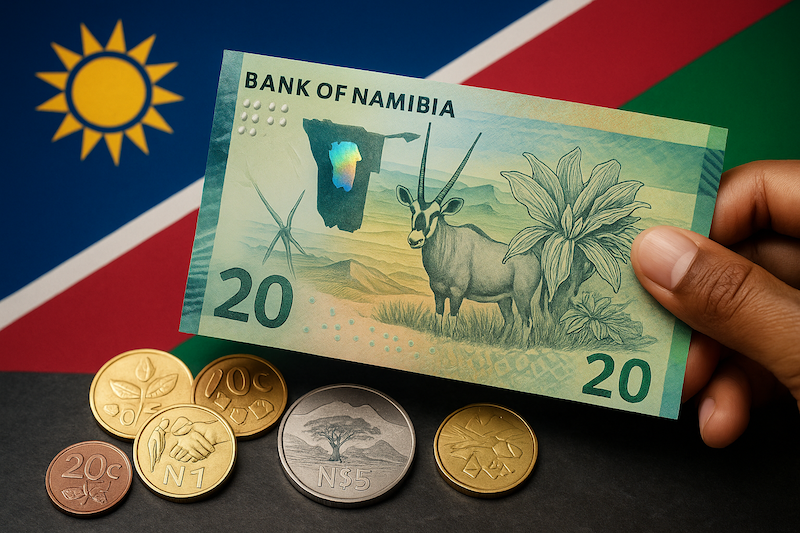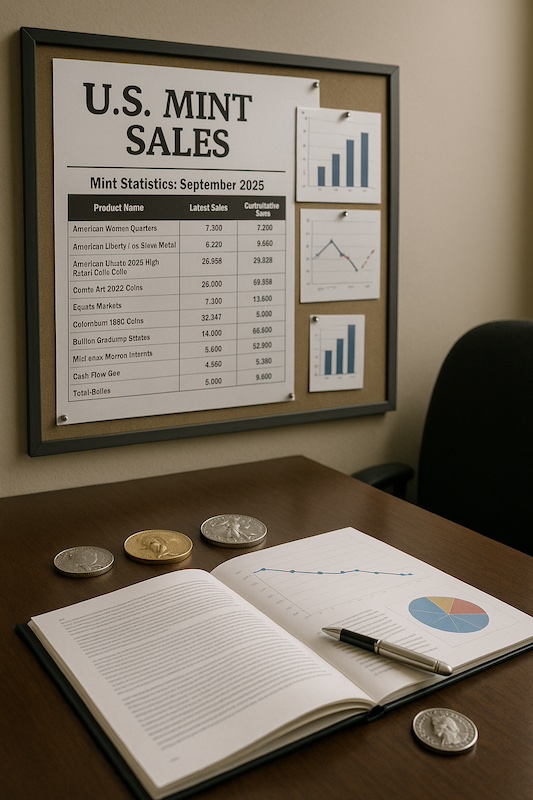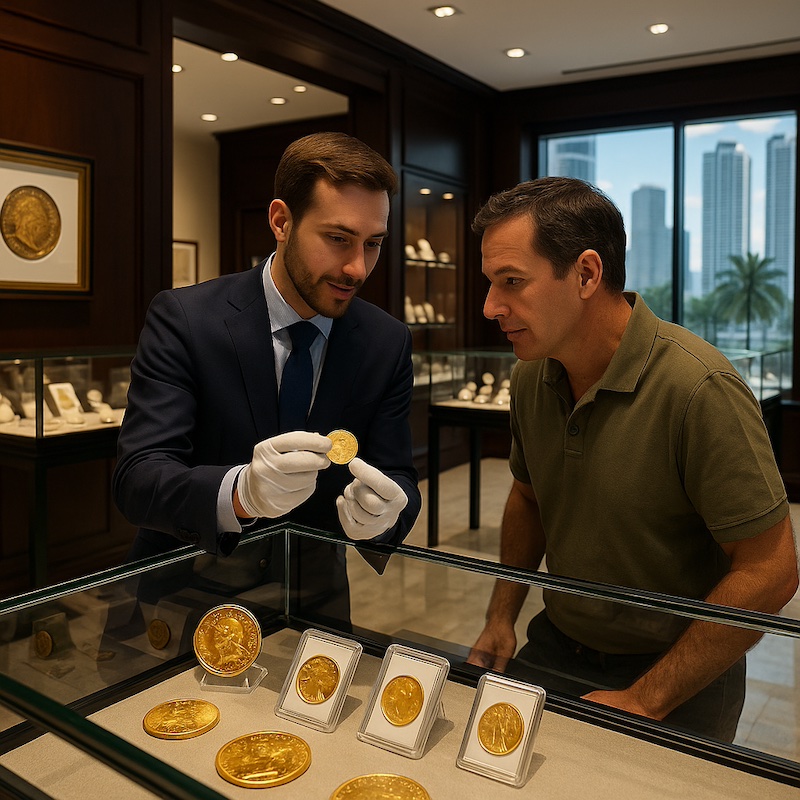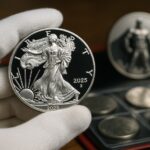Hook: When a central bank refreshes everyday money, collectors should perk up. With the Namibia new banknotes and coins 2025, the Bank of Namibia isn’t just changing colors—it’s modernizing substrates, enhancing accessibility, and re-framing national identity on cash. That means fresh type pieces for album pages, new varieties to study, and a timely case study in how nations update currency for a digital era.
TL;DR
- Bank of Namibia launched upgraded banknotes and a brand-new coinage series under the theme “Our Currency, Our Heritage, Our Pride,” entering circulation August 2025 with co-circulation alongside current notes and coins.
- The N$10 and N$20 are printed on a composite (paper-polymer) substrate for durability with a familiar paper feel; tactile features aid visually impaired users.
- Coins shift from flora/fauna to economic-sector motifs (agriculture, manufacturing/renewables, tourism, retail, mining) and add a new 20-cent denomination.
Why this currency upgrade matters now
Thirty-five years after Namibia’s central bank was founded and three decades after the Namibia dollar debuted, the Bank of Namibia has unveiled a comprehensive overhaul of notes and coins. It’s billed as a security, functionality, and identity upgrade—not merely aesthetic. For collectors, that equals new designs, new materials, and new issuance data to track. For the public, it’s about future-proofing cash against counterfeiting while keeping it accessible and trusted.
There’s also vital macroeconomic context. The Namibia dollar (NAD) has been linked at 1:1 to the South African rand within the Common Monetary Area since its introduction in 1993, with policy designed to maintain the peg and back currency in circulation with international reserves. Any redesign must respect that stability, even as it moves the currency forward technologically.
Finally, the scale is significant: according to the Bank of Namibia, currency in circulation has grown from about N$200 million in 1993 to over N$5 billion by 30 June 2025—a reminder that design, durability, and security choices affect millions of daily transactions.
Inside the designs: the new coinage series
One of the biggest stories in the Namibia new banknotes and coins 2025 program is on the coin side. For the first complete redesign since 1993, the Bank of Namibia is pivoting from wildlife to economic-sector iconography and introducing a 20-cent piece to improve transaction efficiency. Highlights:
- 10 cents: Mahangu (pearl millet) honoring agriculture and food security.
- 20 cents (new denomination): Manufacturing through a renewable-energy lens, signaling sustainable development goals.
- 50 cents: The landscapes of Sossusvlei and Deadvlei, celebrating tourism.
- N$1: A retail-trade motif—hands exchanging coins—to denote everyday commerce.
- N$5: Polished and rough diamonds, reflecting mining’s role in GDP and exports.
Beyond art, the minting brief emphasizes coins that are lighter, smaller, and more durable, with customized edges to improve denomination recognition—useful both for cash handlers and visually impaired users. Expect fresh varieties in planchet size, weight, and edge features to document in catalogs and third-party population reports once volume hits the market.
The banknotes: composite substrate, security, and accessibility
The upgraded third-generation banknotes retain the familiar national figures—Founding President Dr. Sam Nujomaand Kaptein Hendrik Witbooi—and wildlife reverses, but the production materials and finishes are the headline. The N$10 and N$20 migrate to a composite (paper-polymer) substrate, combining polymer’s durability with paper’s tactile feel to extend lifespan and maintain public acceptance. This is consistent with a broader global trend toward hybrid substrates (e.g., Hybrid/Hybrid ADDvance, Durasafe), chosen for durability and anti-counterfeiting integration.
Why collectors should care: different substrates can produce subtle ink, embossing, window, or thread behaviors; they affect how notes wear, how folds and corners age, and which security features are feasible. Expect Namibia’s new lower denominations to exhibit longer circulation life and less soiling than their full-cotton predecessors, while higher denominations continue to showcase advanced threads, micro-printing, and optically variable elements (specifics as published by the central bank).
Crucially, the Bank of Namibia emphasized tactile features for the visually impaired and partially sighted, aligning with best practices across modern banknote design. Accessibility cues are one of the most pragmatic “user-first” upgrades in recent currency science.
Rollout timeline, circulation, and co-circulation strategy
The Bank of Namibia announced a national rollout in August 2025. New and current series will circulate together for a transition period; public education campaigns are planned to explain features and authentication. For dealers and collectors, this staggered coexistence is a chance to capture early UNC pulls from cash circulation and assemble type sets with minimal friction.
Expert perspective: identity, security, and trust
Central bank leadership framed the launch as both symbolic and practical. Governor Johannes !Gawaxab called it “a historic moment” linked to the bank’s 35-year legacy, and emphasized that currency redesign = trust + innovation, not just new pictures on paper. The official press materials repeatedly tie the program to security, inclusivity, and national story-telling—priorities that align with what collectors prize in modern issues: a coherent narrative and technically sophisticated execution.
How the Namibia new banknotes and coins 2025 compare (at a glance)
| Feature | Previous series | 2025 series |
|---|---|---|
| Theme | National leaders & wildlife | Leaders & wildlife (notes); economic sectors (coins) |
| Coin denominations | 5c, 10c, 50c, N$1, N$5 (common) | Adds 20c; lighter, smaller; customized edges |
| Low-denomination substrates | Cotton-based paper | Composite (paper-polymer) for N$10 & N$20 |
| Accessibility | Limited tactile features | Enhanced tactile cues; education campaign |
| Circulation plan | Legacy designs | Co-circulation with new series from Aug 2025 |
Market implications for collectors, dealers, and investors
Pros
- Fresh type material across both notes and coins creates immediate demand for first-year sets, proof-like pulls, and high-grade slabs.
- Composite substrate on lower denominations should reduce soiling and folds, improving the likelihood of high-grade survivors from circulation.
- Sector-themed coinage offers a coherent story that appeals beyond Namibia—think tourism collectors (Sossusvlei), mining/diamond themes, and sustainability narratives (renewables).
Risks
- Transition periods can foster confusion and opportunistic misrepresentation. Rely on the Bank’s feature guides and buy from reputable sources, especially online.
- Supply dynamics: As the series beds in, avoid overpaying for common circulation strikes. Let availability and condition guide pricing, not novelty alone.
Practical playbook
- Build a 2025 type set: 10c, 20c, 50c, N$1, N$5 plus N$10 & N$20 on composite substrate. Add higher-denomination notes in UNC to complete the narrative.
- Document provenance: Keep Bank of Namibia brochures/pressers with your acquisitions; provenance matters for education and future resale.
- Grade strategically: Submit the most pristine early pulls; hybrid substrates can present different handling/pressing tells than pure cotton—choose experienced paper-money graders. (For general substrate background, see industry references.)
What is a “composite” or “hybrid” banknote—and why should you care?
A hybrid paper-polymer banknote merges a cotton core with polymer layers or windows to combine durability (from polymer) with traditional feel (from paper). Countries and vendors have implemented variants globally for two decades to extend note life and integrate advanced windows/threads. Collectors should note how these substrates affect security threads, windows, and tactile embossing—features that can be distinctive under magnification and UV.
Historical anchor: the peg and the policy framework
For numismatists who appreciate the intersection of currency and policy, Namibia’s monetary regime is a classic case of a fixed-peg framework: the NAD is linked at 1:1 to the South African rand; maintaining adequate international reservesand interest-rate alignment is central to peg stability. Understanding that backdrop explains why the message is “new look, same value”—design and substrate can evolve while parity remains constant.
Release details and what to watch next
- Issue window: August 2025 entry into circulation; co-circulation with existing series.
- Public education: Central-bank awareness campaign on security and authentication.
- Official specifications: Characteristics and approvals are published via formal notices; collectors can monitor the Government Gazette channel for denomination-by-denomination specs as they’re recorded.
FAQs
Are the older Namibia dollar notes and coins still legal to use?
Yes. The Bank of Namibia has indicated co-circulation to ensure a smooth transition, so you’ll see both series in daily use during rollout.
Which denominations switched substrate?
The N$10 and N$20 are printed on a composite substrate; higher denominations continue on conventional high-security paper with updated features.
What’s new in the coins—just art or also specs?
Both: new 20-cent denomination, lighter/smaller pieces overall, and customized edges for easier identification. Themes now represent key economic sectors.
Will there be collector versions (proofs/sets)?
The launch communication focuses on circulation money and public education. Watch the Bank of Namibia or national distributors for any official collector sets or folders that may follow.
Is the value of the NAD changing because of the redesign?
No—hence the slogan “New look, same value.” The peg to the South African rand at 1:1 remains the policy anchor.
Conclusion: a modernized series with story—and staying power
The Namibia new banknotes and coins 2025 program checks the right boxes for both public utility and collector intrigue: clear national storytelling on coins, state-of-the-art substrates on low denominations, and inclusive design across the range. For U.S. collectors, world-note specialists, and numismatists everywhere, this rollout is an opportunity to secure first-year types, study hybrid substrates in African issues, and document a landmark chapter in Namibia’s monetary narrative—new look, same value, but a meaningfully new collecting landscape.








